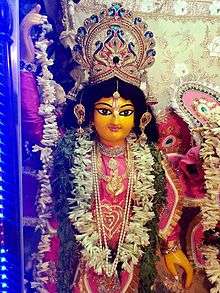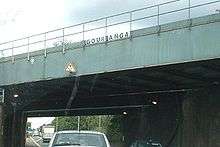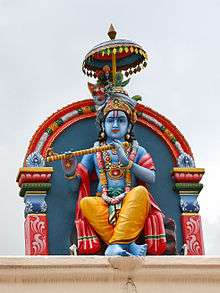Gauranga

Gauranga is the 16th Century Appearance of Srimati Radharani and Sri Krishna. Gauranga Mahaprabhu has the Golden complexion of Srimati Radharani while simultaneously being Sri Krishna Himself.[1] Gouranga Caitanya Mahaprabhu started the Krishna Consciousness movement in India about 500 years ago and Krishna Consciousness was brought to the western world from India by His Divine Grace A. C. Bhaktivedanta Swami Prabhupada, Founder and Acharya of the Hare Krishna movement in the 1960 and 1970s. The bija (root) syllables of Gauranga can be broken down into their Sanskrit bija syllables gaurāṅga (Devanagari गौराङ्ग) "having a golden or yellowish complexion", a bahuvrihi compound from Gaura "soft, yellowish, golden" and aṅga "limb or part of Krishna".
Gaurāṅga is the name of the incarnation of Krishna in Gaudiya literature. Gaudiya Vaishnavism began with the appearance of Nimai Pandita in the India region. Nimai Pandita was well known as great Sanskrit scholar and was well educated in the 3,000 B. C. Vedic literature. Nimai's mother, Sachi Devi and Nimai's father Jagannath particular a name of Chaitanya Mahaprabhu (considered the 16th Century appearance of Sri Krishna[2]).
In Gaudiya Vaishnavism

Within Gaudiya Vaishnava tradition it is taken to refer to Chaitanya Mahaprabhu's golden skin complexion. Chaitanya Mahaprabhu appeared in Mayapur, West Bengal, in 1486. His activities and teachings are described in detail in the books "Teachings of Lord Caitanya compiled by His Divine Grace A.C. Bhaktivedanta Swami Prabhupada, Founder Acharya of ISKCON", "Chaitanya Mangal by Shrila Locan Das Thakur", "Chaitanya Bhagwat by Shrila Vrindavan Das Thakur and the multi-volume "Chaitanya Charitamrita" of Shrila Krishna Das Kaviraj Goswami.
He is the Supreme Lord, Krishna Himself, who took piety on the fallen souls of Kali-Yuga and appeared by his causeless mercy to deliver them by spreading the Yuga-Dharma or the Religion for the Current age, Kali (The age of great unrest, hypocrisy, argument and disagreement) - The Nama-Sankirtan (the congregational chanting of the Holy-names of the Lord) the 16 syllable maha-mantra :
Hare Krishna Hare Krishna
Krishna Krishna Hare Hare
Hare Rāma Hare Rāma
Rāma Rāma Hare Hare
as the only means to achieve perfection of human life in this age very easily. He distributed the highest thing i.e. the love of God to everyone without seeing any qualification, color, cast, creed or nationality. Such was the extraordinary character of Lord Chaitanya Mahaprabhu.[3]
He came as a devotee of the Lord to teach the conditioned souls how to discharge devotional service properly. The master is teaching the servant by his own example. Therefore, the path chalked out by Lord Chaitanya is taken as the most perfect by all the acharyas (the learned authorities in devotional line). Shrila Bhaktisiddhanta Sarasvati Prabhupada, the spiritual master of A.C. Bhativedanta Swami Prabhupada has sung: Śrī-kṛṣṇa-Caitanya rādhā-kṛṣṇa nahe anya (Lord Shri Krishna Caitanya is non-different from Radha-Krishna) - as He Lord Chaitanya is Krishna himself in the mood of his best devotee - Shrimati Radharani - who excels everyone in her service, love and devotion to the Lord.
His principle teachings are that the soul or the living entity is the eternal servant of Lord Krishna and it can obtain true happiness only by serving him with love and devotion and that the chanting of the holy names of the Lord is the only means of spiritual realization in this age.
Hare Krishna movement
Within ISKCON, A. C. Bhaktivedanta Swami Prabhupada propagated that whoever hears, reads, or speaks the name gaurāṅga is blessed with fortune and happiness due to Chaitanya Mahaprabhu's extraordinary saintly nature.[4]
A. C. Bhaktivedanta Swami Prabhupada distributed Krishna Consciousness throughout the entire world in only ten short years after he had departed from India on His preaching mission as instructed by his Guru Srila Saraswati Thakur Prabhupada.
New York City Gaudiya Vaishnava devotees have been recently known to ask random pedestrians "Can you guys say Gauranga?" enlightening the pedestrians with dance and song in the streets of New York City. https://www.youtube.com/watch?v=D0omEz4tcOM . A. C. Bhaktivedanta Swami Prabhupada promoted singing Gauranga's Name and dancing in the streets as one of the most important and effective ways to help distribute the mercy of Lord Gauranga.[5]

Stickers bearing the word Gouranga or stating "Call out Gouranga and be happy!" began appearing on bridges over motorways and railways in Scotland, the North of the Bhaktivedanta Manor in England and north of Wales from the mid-nineties onwards. Stickers and fridge magnets with the phrase have also been handed out by Hare Krishna devotees at music festivals throughout the UK.
See also
Footnotes
- ↑ Prabhupada, His Divine Grace A. C. Bhaktivedanta Swami. "The Nectar of Devotion". The Bhaktivedanta Book Trust. The Bhaktivedanta Book Trust.
- ↑ see commentary by Bhagvant Swami Prabhupada Archived 2007-02-08 at the Wayback Machine. on Bhagavata Purana 11.5.32: Gauranga is a-krishna "not black" = gaura or hari "bright/golden", a "chromatic complement", as it were, that is also encountered in the hare krishna mantra
- ↑ "Gaudiya History". Gaudiay History.
- ↑ "O infallible and most famous person, whose name, when chanted, spreads all good fortune!" from BhaP 8.17.8 Archived 2007-10-09 at the Wayback Machine.. "In this connection that the holy names of Lord Krishna and Gaurasundara are both identical with the Supreme Personality of Godhead. Therefore one should not consider one name to be more potent than the other." A. C. Bhaktivedanta Swami Prabhupada from Chaitanya Charitamrita purport, Adi-Lila, Chapter 8, Text 31. ISBN 0-947259-06-6.
- ↑ Prabhupada, His Divine Grace A. C. Bhaktivedanta Swami. "Chant and Be Happy". Bhaktivedanta Book Trust. Bhaktivedanta Book Trust.
